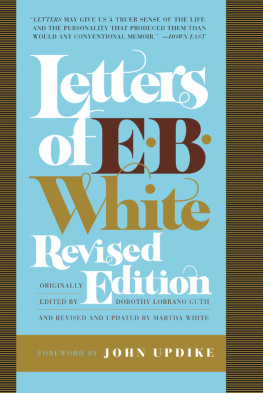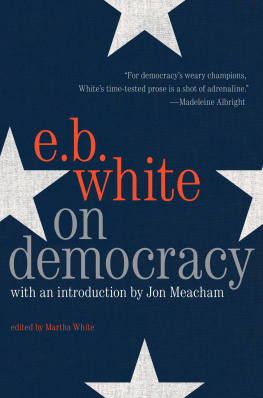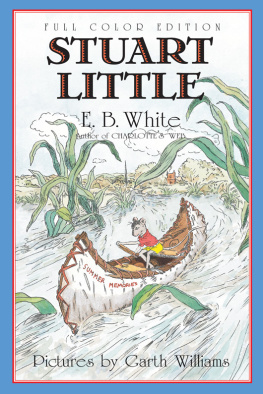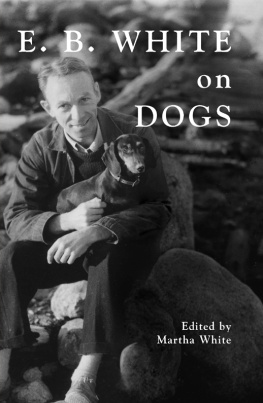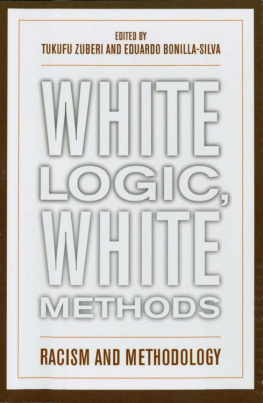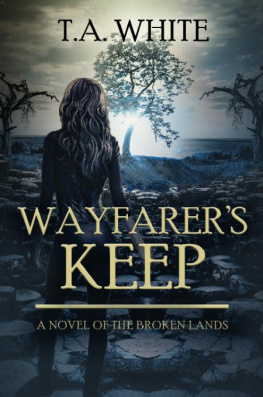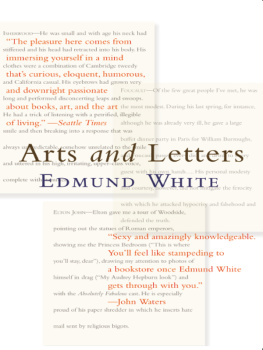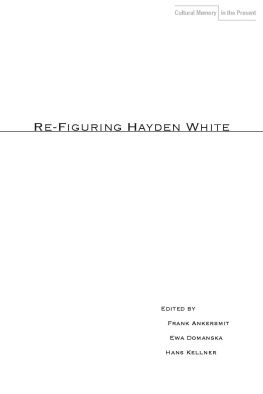E. B. White - Letters of E. B. White
Here you can read online E. B. White - Letters of E. B. White full text of the book (entire story) in english for free. Download pdf and epub, get meaning, cover and reviews about this ebook. publisher: HarperCollins, genre: Non-fiction. Description of the work, (preface) as well as reviews are available. Best literature library LitArk.com created for fans of good reading and offers a wide selection of genres:
Romance novel
Science fiction
Adventure
Detective
Science
History
Home and family
Prose
Art
Politics
Computer
Non-fiction
Religion
Business
Children
Humor
Choose a favorite category and find really read worthwhile books. Enjoy immersion in the world of imagination, feel the emotions of the characters or learn something new for yourself, make an fascinating discovery.
- Book:Letters of E. B. White
- Author:
- Publisher:HarperCollins
- Genre:
- Rating:3 / 5
- Favourites:Add to favourites
- Your mark:
- 60
- 1
- 2
- 3
- 4
- 5
Letters of E. B. White: summary, description and annotation
We offer to read an annotation, description, summary or preface (depends on what the author of the book "Letters of E. B. White" wrote himself). If you haven't found the necessary information about the book — write in the comments, we will try to find it.
Letters of E. B. White — read online for free the complete book (whole text) full work
Below is the text of the book, divided by pages. System saving the place of the last page read, allows you to conveniently read the book "Letters of E. B. White" online for free, without having to search again every time where you left off. Put a bookmark, and you can go to the page where you finished reading at any time.
Font size:
Interval:
Bookmark:

Family portrait, 1899.
101 Summit Avenue, Mount Vernon, New York.
Jessie and Elwyn in Mount Vernon, with Beppo, an Irish Setter.
Samuel Tilly White posing at Rangeley Lake.
Lillian and Elwyn, Clinton Corners, New York.
Elwyn, tending a rabbit.
Samuel and Elwyn.
Lillian and Elwyn, 1906.
Elwyn and mandolin.
Elwyn, in elementary school.
Elwyn, in grammar school.
Elwyn, at Cornell.
The White family men.
Great Pond, North Belgrade, Maine, 1905.
ELWYN. Belgrade, about 1910.
The White family, aboard Jessie.
Whites Model T, called Hotspur.
Becker Caf, Hardin, Montana.
August, 1923, on the S. S. Buford, near Nome, Alaska.
Katharine Sergeant Angell, shortly before her marriage to White.
White in his New Yorker office; the dachshund is Minnie.
Following page 330
Andy and Katharine, around 1930, at Samuel and Jessie Whites golden anniversary party.
Andy and Katharine at work on A Subtreasury of American Humor.
White and James Thurber, Snedens Landing, New York about 1929.
Harold Ross.
James Thurber and E. B. White.
Andy with Joel McCoun White, born December 21, 1930.
Katharine with infant Joel in the pram and Daisy on a leash.
Katharine White and her three children, Joel White and Nancy and Roger Angell.
The Whites farm in North Brooklin, Maine.
White, 1940s.
Roger Angell and Joel White.
Katharine and Joel on the shore at Walkers Pond.
The cutter Astrid in Tenants Harbor, Maine.
Joel White at Exeter Academy, about 1945.
Dachshund, Fred.
Katharine aboard Astrid, about 1935.
Katharine and Andy and dachshund, Minnie.
Nancy Angell at the helm and her mother, Katharine.
Katharine and Andy, feeding the sheep.
Following page 458
Joels wife, Allene White, in Maine.
Allene, Joel, Steven, and Martha, stationed in Grossenhausen, Germany, 1955.
Katharine White, by Peter Arno.
E. B. White, by James Thurber.
William Strunk, Jr., author of The Elements of Style.
White receiving the Presidential Medal of Freedom from Maines Senator Edmund Muskie, 1964.
Katharine in her New Yorker office.
Colson Henry Allen.
White with a robin on his shoulder and a cup of worms, 1964.
Joel M. White, in his Brooklin Boat Yard office, early 1990s.
The good sloop Martha.
One of Whites rare speeches, at launch day.
Rowing out to the Martha, Brooklin Boat Yard in the background.
White, feeding the sheep outside the barn.
Katharine and Andy and dog, Susy.
White in his eye patch, early 1984; the dog is Jones.
by John Updike
The prose of E. B. White, as manifested in his letters, lopes along sensibly and informatively, like many other peoples, until it delivers an unexpected poetic punch. Looking at just the hitherto unpublished letters in this revised collection, we find, apropos of his packing and dispatching the papers of his recently deceased wife:
The labor has been time-consuming and exhausting as well as melancholy; I now wander about this old house staring into empty shelves and fighting back memories.
Fighting backthe sensation, familiar to all who have grieved, is caught with a rare bluntness and resonance. Some months later, White turns his eye on a dogs loneliness: One day while I was away he found a wool shirt of mine in the livingroom and proceeded to take it all to pieces. Whether from anger or from uneasiness I do not know. Uneasiness was, in old age and youth, Whites element. His writing career began, according to a thinly fictionalized portrait of a Mr. Volente, when a waitress in a Childs restaurant spilled a glass of buttermilk on him: Mr. Volente had written an account of the catastrophe at the time and sold it to a young and inexperienced magazine, thus making for himself the enormously important discovery that the world would pay a man for setting down a simple, legible account of his own misfortunes. At the opposite end of Whites career, the misfortunes of old age are echoed in the fall of a tree:
I spent hundreds of dollars trying to save my elm, but it didnt work. The tree landed on the lawn with a tremendous thuddd. Now they want me to spend a lot of money trying to save my retinas, but that isnt going to work, either.
This painfully sensitive and clear-sighted man found the world of artistic enterprise also productive of thuds, as when his childrens classic Charlottes Web was made into an animated movie: After listening to Wilbur sing I Can Talk, I Can Talk, in the Hanna-Barbera picture, I can take anything. I wanted to run on my sword but couldnt find it.
Much of Whites correspondence in the last years of his life was directed, with an asperity softened by affection, to Scott Elledge as this Cornell professor labored on Whites biography. Patiently White corrected errors, provided facts, delivered droll demurs:
I feel the manuscript, even with the cutting you have done, is too long. The horrid truth is, my life is not all that interesting. I kept falling asleep over it, even though it was my life.
When the manuscript had become a book, its subject expressed misgivings about the jacket blurb:
The blurb calls me Americas most beloved writer. That is not only open to question, it isnt a good pulling idea anyway. Im an old advertising man, and I know that people would rather buy a book about a writer everybody hates the guts of.
Some months later, he rather shockingly describes the biography to its author as your book about the American author who never quite made it into the big time. Two years earlier in their collaboration, White both bowed out and bowed in, telling Elledge:
I would think twice about describing the vigorous part I played in your final revisions lest you give readers the idea that Ive been breathing down your neck and writing my own story. It is, after all, unusual to have a subject of a biography still alive and kicking, and I have felt uneasy in this role and uncertain just how to behave. I have been torn between the strong desire to keep out of it and the equally strong desire to help clarify it.
Whites collaboration with Dorothy Lobrano Guth, his goddaughter, in the 1976 publication of nearly seven hundred pages of his letters also stirred unease. This invasion of his own privacy, and to an extent that of his correspondents, went against his grain, and probably would not have occurred had not Katharine Whites long and expensive illnesses made it seem necessary. The note he attached to that volume said as much, with typical bounce and reticence:
Ideally, a book of letters should be published posthumously. The advantages are obvious: the editor enjoys a free hand, and the author enjoys a perfect hiding placethe grave, where he is impervious to embarrassments and beyond the reach of libel. I have failed to cooperate with this ideal arrangement. Through some typical bit of mismanagement, I am still alive, and the book has had to adjust to that awkward fact.
Living long enough to be a reluctantly coperative party to his biography and his collected letters was a bother, even something of a plague, for him, but a boon to the multitudes of White lovers, in the many corrections and felicitous refinements he lent to the two tasks. Letters of E. B. White is by far his longest book, and by many measures his most autobiographical. It opens with ten lovely pages, in italics, that he supplied on the subject of his happy childhood in the New York suburb of Mount Vernon. The first letter published, to his brother Albert, was composed when he was nine and shows a flash or two of the compression, crystal clarity, and lightly worn melancholy which would become characteristic:
Next pageFont size:
Interval:
Bookmark:
Similar books «Letters of E. B. White»
Look at similar books to Letters of E. B. White. We have selected literature similar in name and meaning in the hope of providing readers with more options to find new, interesting, not yet read works.
Discussion, reviews of the book Letters of E. B. White and just readers' own opinions. Leave your comments, write what you think about the work, its meaning or the main characters. Specify what exactly you liked and what you didn't like, and why you think so.

